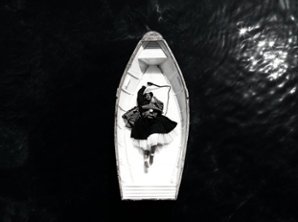In each of three boats, a figure lies with their head toward the prow: a woman with a hawk perched on her arm, a young man in a stylish hat, and another woman wrapped in a woolen Basotho blanket. As the vessels fill with water, the figures thrash about in resistance but eventually succumb to the inevitable pull of the tides. The water of Passage refers to the transient experiences of the countless enslaved and indentured people who passed through the Dutch and British Cape Colonies, present-day South Africa, during the colonization of the 17th through 19th centuries. Along with other cargo, these Europeans brought people from the Indian subcontinent, Indonesia, Madagascar, East Africa, and Angola to work the farms and ports that extracted resources from the territory and moved this wealth around the world.
Soweto, part of the city of Johannesburg where artist Mohau Modisakeng was born, remains an industrial mining city deeply marred by this colonial history and the more recent aftermath of 20th-century Apartheid, a governmental system that discriminated against and disenfranchised non-white South Africans. In the Setswana language spoken by the artist’s family, life is thought of as a passage and is called botshelo, which means “to cross over.” Humans are called bafeti (voyagers), a word that acknowledges the transience of the human experience.
To reflect on this complex history, the South African Department of Arts and Culture commissioned Mohau Modisakeng to make Passage for the South African pavilion of the 57th Venice Biennial in 2017.
Mohau Modisakeng, Passage, 2017
Three-channel video with sound, 18:48, Edition of 10 + 2 AP
Courtesy of the artist and Galerie Ron Mandos, Amsterdam



